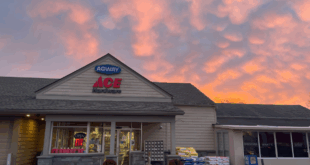As a component of its Distributor Profile series, Hardware Retailing spoke to two executives at Do it Best Corp. to learn more about the company’s commitment to serving independent retailers through enhancements to supply chain and marketing initiatives.
Steve Markley, Executive Vice President of Operations
Rich Lynch, Vice President of Marketing
Here to Everywhere
How Do it Best Executes a Comprehensive Supply Chain Plan
 Steve Markley
Steve Markley
Executive Vice President of Operations
Steve Markley brings more than 30 years of industry experience to Do it Best. He assumed his current role in 2018 and uses his experience to lead teams in enhancing operations and continually improving supply chain excellence.
Hardware Retailing (HR): What role do the teams you oversee play in serving Do it Best members?
Steve Markley (SM): The role I have is really about working with our teams to make sure we’re providing excellent support and service to our members, day to day, week to week, and month to month on the core basics: distribution, marketing, sales, program and product support. It’s also about working with our teams on strategic initiatives, investments and enhancements to our services and programs so we’re well-positioned to help our members succeed.
Through those efforts, we’re working to coordinate the strategies across all of our divisions so we’re really focused and delivering tangible results for our members.
HR: How have you optimized your supply chain to meet the needs of your members?
SM: Distribution excellence is one of our strengths—it goes to the core of what we do. So continuous improvement is absolutely a key driver for us. We work day to day to find efficiencies, cost savings and ways to improve our service to our members, but we also make those big strategic commitments and investments.
Last year, we rolled out a transportation management system, and that was certainly a strategic commitment. Through the use of that system, we will cut about a million miles out of our delivery routes to our members.
This system also helped us be more agile in the formation of those routes, more flexible in how we can adapt to situations. By mining the data that’s available in that transportation management system, we’ve also seen logistical improvements. Over the last six months, we achieved our highest on-time delivery rates to our members. It’s really important that product gets there, and it gets there on time, so our members’ customers have what they want when they want it.
Another investment and strategic initiative is an upgraded forecasting and replenishment system. That tool is all about having the right products at the right places at the right times for our members so they can succeed and win at retail.
When we look forward, supply chain is critical. For us, some other initiatives that we are continuing to invest in is what we do with our product content. I’m looking at content as an asset, so it’s about more robust data on the items we have that our members buy and sell to their customers.
It’s providing that data to them in a very user-friendly way, so it’s very accessible for them. They can search and find the information they need quickly for their needs or for their customers, and the front-facing piece of that is our online catalog that goes out to our members.
We’re also working on enhancements to our ordering system to make our ordering process for our members even more user-friendly, but also more flexible and agile.
The third one I would call out is inside the four walls of distribution centers—our warehouse management system. That investment is about improving the flow of goods into and out of our warehouses more quickly and more efficiently so we can get goods to our members when they need them, where they need them and how they need them.
These are big investments in our supply chain and to our core strategic components. Beyond the delivery of product, but also related to supply chain and growing members’ businesses, we’re making investments in our marketing and promotional management tools, like the Digital Dashboard, which allows our members to plan and execute comprehensive marketing plans and have good visibility and tracking of their spend. It’s really simple to use, but it gives them a great snapshot of where their marketing dollars are going and where they would like them to go.
HR: How is Do it Best helping retailers implement innovation in their operations?
SM: Innovation can mean many different things. Sometimes it’s technology, like the Digital Dashboard. On the retail side, a big part of it is helping members connect locally with their customers in a way that makes sense for them. When you go inside the store, I look at something like The Color Bar, which is a store-within-a-store paint program we launched in the spring of 2017. When it comes to a product like paint, you’re not selling just cans of paint, you’re selling color, so that program helps members update their departments to be relevant for today’s consumer. It meets them where they are, whether it’s in store or online.
Our members who have implemented The Color Bar are seeing double-digit increases in their paint department sales, so staying in that conversation with members about a core department like paint is about making sure they are relevant for today’s customers and have the right tools in place inside the store to make them as successful as they can be.
HR: What is the Do it Best approach on providing a menu of services without making mandates for members to use particular services?
SM: We’ve never been one to say, “here’s what you must do.” There are very few, if any, mandates where something is required.
We’ve been much more at the other end of that continuum, which is about saying, “Here’s what you could do.” What we’re shifting toward is the thought process of showing our members the options they have that they should be considering to becoming stronger in certain areas. We’re working to incorporate data into those recommendations and doing that with our planogram development and our promotional items. These are focused programs that we call out to members as opportunities—niche categories that work for certain regions or certain profiles of members. Also, since we are the only full-service co-op for both hardware and lumber operations, our strategy is to highlight all of those crossover departments to call out those opportunities for all members. We show members what they should consider and what they really should be doing. We don’t tell them what they must do, but what they can do.
We’re working on executing and delivering on the plan, and when you string a bunch of singles together, you score a bunch of runs. We have these initiatives and strategic plans, and we strive for continuous improvement to bring those opportunities to members to help them grow their businesses and provide the support, services and programs they need to be successful, be responsive. Those things have served us well and will serve us well going forward. All of our new initiatives and strategies mean we’re not just sitting down and accepting the status quo. We have to move forward and move forward aggressively.
We’re proud of our members and their performance and our role in helping them. We know we’re very committed going forward to continue to serve members. Our member-owners are who we serve. We’re very committed to providing them with the tools, programs and services they need to succeed.
Diving Into Marketing
The Digital Dashboard Keeps Retailers Connected
 Rich Lynch
Rich Lynch
Vice President of Marketing
As vice president of marketing for Do it Best, Rich Lynch is responsible for all components of member marketing, including education, communications and more. He brings more than 25 years of experience to his role.
Hardware Retailing (HR): What’s your overall approach to marketing?
Rich Lynch (RL): Our approach for marketing is to make sure we establish our member locations as the first and best choice in their communities, and I think we do that a couple of different ways.
First, we help them work on what a strong message is for their business in a single, strong story. We make sure it’s one that’s relevant to the customers they’re trying to reach. Then, it needs to be a message they can carry out in their stores with absolute excellence.
If you think about it, we’re making a promise. We are making sure the promise we make matters to the person we’re making it to, then we make sure that we’re following through on that promise. We believe we can do that with our members in a way that it’s their promise, it’s their execution, it’s their customer. We think that’s a much more efficient and effective way to establish them as the first and best choice in their markets.
HR: You launched the Digital Dashboard in 2017, which is a comprehensive digital marketing manager. What’s the strategy behind that program and how does it serve retailers?
RL: The dashboard came up as an offshoot of what’s happening in marketing in general. We have a very traditional way of marketing that many of our members have grown very, very good at and very accustomed to. The dashboard gave us a way to help them broaden their horizons and get out there so they get found, get noticed and sell more product.
It’s not enough to just get found or noticed if that’s not translating into product sales. So we think all three of those elements are really important. But what we think is best about the dashboard is it allows us to help our members bring order to some perceived chaos in the digital space. For a lot of people, this digital space is new, and it’s revolutionary. They’re not sure what to do with it or how to respond to it.
The dashboard gives us a way to help them get into it, and they can get into it by putting a toe in, or they get into it by diving all the way in. That’s the beauty of what we put together. It really meets our members where they are in their level of digital acumen, digital strategizing and digital comfort. It lets us meet them where they are and come up with something that will let anyone in any spot along those spectrums do a really good job with getting their message out.
HR: What are the different components of the Digital Dashboard?
RL: It’s what you would expect out of a digital marketing management system today. It includes Google Ads (online advertising) buys, social media postings, emails and all the other things out there that we would expect someone to have as part of their digital marketing strategy. Google Ads, social and email are the big three, though.
The great thing about the dashboard is it allows members to set a budget. They can opt in and opt out on a month-to-month basis, depending on how their marketing promotional planning calendar looks, so we give them full flexibility to get in or get out. They can go shallow or deep in a given month with whichever tools they feel are going to be most effective for the message they want to get out.
One of the challenges retailers have with marketing in general is that it’s hard to measure impressions and results. What’s nice about working in the digital space is it lets retailers see exactly who saw what when, and then they can do a better job of planning out what I would call “smart spend” going forward based on the results of the analytics.
HR: Why is technology an important component of a marketing plan?
RL: Ten years ago, technology and marketing were in some ways like oil and water, but now they’re very much blended together. It’s because of the digital aspects. What is really interesting is, in some ways, technology and marketing have begun to merge or overlap. If you think about how marketing used to be, you were targeting somebody who was in a predictable time and place and referencing a set medium. Pretty much everything about it was predictable. Now we’re marketing in a world where nothing is predictable, and the person we’re trying to market to isn’t stationary, they’re mobile.
And they’re mobile in terms of location, but also in terms of what media they’re using. They’re cross-channeling quite a bit. So we’ve got to make sure what we do with technology is meeting consumers where they are. I believe our marketing approach today does that.
HR: What other marketing tools does Do it Best offer?
RL: In the last year and a half, we’ve completely redefined and reorganized our marketing. We’ve gotten focused not so much on advertising, which I think in most people’s thought processes is often narrowly focused on print, billboards, TV and radio, which can be very limiting. Today, we prefer to look at it in terms of consumer marketing, and that brings in all of it. When you think about it that way, you’re much more likely to get an integrated plan as opposed to separate and differentiated parts that don’t always work as well as they should together. We tie that together under the banner we call, “Winning the Weeks That Matter Most.”
In our business, you have 52 weeks a year. You can argue that all of them matter, but you can’t argue that they all matter in the same way. So we’re working with our members, and even internally, to identify what weeks matter most.
The only way we measure that is by where the sales come, where the visits come. Then we want to make sure that we’ve got the right message, teed up in the right way, with the right items at the right prices served to our members so they can then serve it to their customers in a way that matters most to them—whether that’s digital, print, broadcast or email. We want to make sure that retailers are positioned to deliver their messaging in the right way. To help members, we put together a team of consumer marketing specialists to work with our advertising service representatives. We believe there’s enough room there for growth and for strategizing to have one part of the team, the consumer marketing specialists, focusing on what the marketing strategy ought to be, how we are going to reach the right people. Then you have the advertising service representative who can really focus on how to best deliver the strategy once we’ve decided what it is.
What weaves all that together is this mindset Do it Best has of transitioning members from what they could be doing to what they should be doing.
Now we have data to tell us empirically what the right things to do are. We can tell a member what the right weeks for a promotion are. Research takes opinion out of it and debate out of it. The numbers say very clearly, “Here are the weeks that matter.”
So the role of the consumer marketing specialists and the advertising service representatives is to start moving our members away from what they’ve done in the past into what they ought to do going forward. You can tell somebody what they can do. You can tell them what they should do. We are good at telling retailers what they should do based on data, based on expertise and based on the tools they have available.
HR: How has marketing changed for retailers?
RL: Marketing is more involved than it’s been in the past. We’ve identified at least eight different elements of a good marketing plan. For us it’s traditional advertising, loyalty programs, digital, online, in-store, social, email and store design. We offer a resource to help members pull all of those together into a comprehensive plan.
The beauty of our approach is that it acknowledges that the needs of an individual member’s business may require turning up the volume on one of them and turning down the volume on another. When we talk about what you should do, it’s about helping our members figure out what that right mix is. One member may need a heavy focus on print because of their demographics, but another member might need a heavier focus on loyalty, and that then becomes a primary driver. In order to do customer loyalty, you ratchet print down a little bit. We think that all of these components are important, but we know the recipe is going to vary a little bit, and our approach is to help our members figure out what the right recipe is for their marketing and their audience.
Customers have more and more choices, so the actions we take to help our members become the first choice and reinforce that they are the best choice will go a long way toward fending off competition.
 Hardware Retailing The Industry's Source for Insights and Information
Hardware Retailing The Industry's Source for Insights and Information






